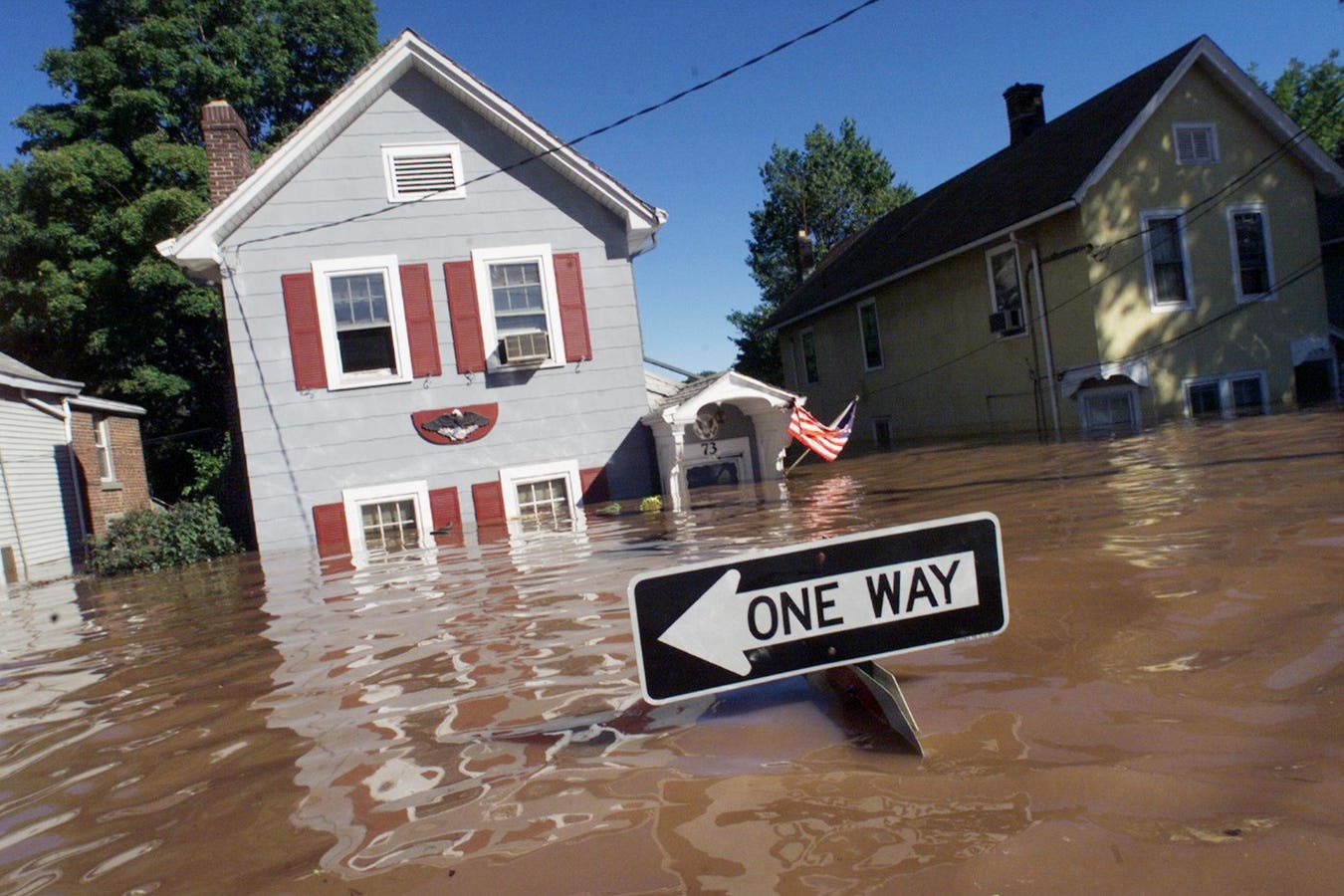UNITED STATES – SEPTEMBER 17: Street is flooded in aftermath of Hurricane Floyd in Bound Brook, N.J. (Photo by Mike Albans/NY Daily News Archive via Getty Images)
NY Daily News via Getty Images
The global insurance industry has crossed a line that should give every boardroom pause. According to Verisk’s just released 2025 Global Modeled Catastrophe Losses Report, insured losses from natural disasters have surged to an average annual baseline of $152 billion dollars, a 25% jump in just one year. Once dominated by rare megacatastrophes, the balance of risk is shifting to frequency perils such as severe thunderstorms, floods, and wildfires, which now account for nearly two-thirds of losses.
The shift is already visible in the data, explained Giovanni Garcia, senior vice president at Verisk’s Extreme Events Solutions unit in an interview. “The $152 billion number, nearly two thirds of that is now made up of frequency perils. And what we’ve also seen over the last five years is that the number of severe thunderstorms that cause a billion-dollar loss has increased by 59%.” That pattern reflects a structural rise in baseline losses, not a statistical anomaly.
The New Normal Of Catastrophe Costs
Verisk’s analysis shows why the curve keeps bending upward. Four forces drive the increase: rapid urban expansion into hazard-prone areas, inflation pushing up asset values, continued migration into vulnerable coastal and metropolitan zones, and the growing climate signal itself. Together these dynamics are compounding risk faster than insurers can reprice it.
In the last five years, insured catastrophe losses averaged $132 billion annually, a figure itself from the $104 billion in the prior period. Verisk warns the industry should prepare for worse: there is a 90% chance that losses in at least one year this decade will exceed $250 billion dollars.
This year also marks the 20th anniversary of Hurricane Katrina, still one of the most consequential disasters in modern financial history. Katrina caused total economic losses of around $160 billion in 2005 terms, with insured losses reaching $105.5 billion. Adjusted for today’s dollars, the bill would be roughly double, placing the storm well above $200 billion in insured losses alone. That comparison underscores why Verisk’s $250 billion warning is not hypothetical. A Katrina-scale event today would push insurers, reinsurers, and capital markets to their limits, with consequences not only for policyholders but for credit markets, mortgage lenders, and public budgets. That recognition is beginning to shift from insurers’ balance sheets into central banks’ risk frameworks
Climate As The Great Risk Multiplier
Climate change accounts for only about one percent of year-on-year increases in modeled losses, but that figure understates its significance. Of the $152 billion only around 1% can be attributed to climate change but, Garcia explains, “If I was going to look at how the losses emanate from human behavior, that’s 7% year on year exposure growth for 1% change in the loss estimate from climate change.”
This contrast highlights climate’s role as a risk multiplier. It does not always appear as the largest direct driver when compared with inflation or exposure growth, but it amplifies the impact of both. Rising temperatures and more volatile weather patterns make existing vulnerabilities more dangerous and magnify the cost of human and economic choices.
Building into floodplains or wildfire zones is always risky, but rising temperatures, shifting rainfall patterns, and more volatile weather can turn those decisions into systemic threats that overwhelm local economies. Inflation raises the value of assets at risk, and when climate change shortens the return period between extreme events, recovery periods shrink until the economics of rebuilding no longer add up. Supply chains concentrated in vulnerable coastal or riverine regions suddenly become global choke points when a climate-driven disruption strikes.
The recognition of climate as a multiplier of other risks is now reshaping financial systems. In July, the European Central Bank announced that from the second half of 2026 it will introduce a climate factor into its collateral framework. The new mechanism will reduce the value assigned to corporate bonds and other assets used as collateral if they are judged to be more exposed to transition-related climate risks.
The adjustments will be based on three elements: sector-level vulnerability as revealed by ECB stress testing, issuer-specific exposure to transition pressures, and the maturity of the instrument. By applying a haircut to the collateral value of climate-exposed debt, the ECB is explicitly embedding climate risk into the eurozone’s financial plumbing. In effect, the central bank is declaring climate not just an environmental threat but a financial hazard that must be priced into core monetary operations.
Profitability On The Brink
The consequences for insurers are already stark. A recent Nature study modelled how climate-driven hurricane damages could cut profitability for US homeowners insurers by between 11-100% depending on volatility and risk appetite. In some scenarios the market fails to reach equilibrium entirely, leaving regions effectively uninsurable without public intervention.
Without adaptation, profitability collapses and solvency risks rise. The study points to a way forward. Insurers could help preserve viability by directing investment toward adaptation and resilience. Stronger, more robust assets reduce expected losses, which in turn lower insurance costs and improve borrowing conditions. Resilience pays twice: first in reduced disaster costs and again in cheaper capital.
Insurability As The New Credit Rating
Howden’s recent Insurability Imperative report made the link explicit. “Maintaining insurability is fast becoming as important as maintaining a credit rating,” said Isabelle Cadignan, chief commercial officer for Climate Risk and Resilience at Howden. “Boards need to understand that insurability is not fixed – it’s dynamic, shapeable, and critical in accessing affordable capital in the climate era.”
For boards, this means treating insurability as a forward-looking credit rating for climate risk. If you cannot insure it, you cannot finance it. That holds true for real estate developments in wildfire zones, industrial projects in floodplains, and global supply chains tied to storm-prone ports. Catastrophe pools, parametric products, and regulatory experiments like California’s PRID wildfire model approval, which requires insurers to provide credits for households that implement risk mitigation measures, show how markets are adapting under pressure.
Protection Gaps And Capital Fault Lines
The scale of the protection gap adds urgency. The number of billion-dollar disasters has soared, rising from just a handful annually in the 1980s to more than two dozen in recent years in the United States alone. In 2024, global economic losses from natural disasters reached $368 billion, yet less than half of that was insured. The shortfall leaves households, companies, and governments to absorb losses directly, slowing recovery and compounding systemic risk. Emerging economies are hit hardest, with protection gaps exceeding two-thirds of total losses, creating fault lines in global capital allocation as investors retreat from markets seen as uninsurable.
From Risk Transfer To Risk Leadership
For companies the message is clear: insurability is no longer an afterthought, it is a strategic indicator of competitiveness. Businesses can and should use catastrophe models themselves to establish baseline risk profiles, stress-test scenarios, quantify protection gaps, and justify resilience investments.
As Shane Latchman vice president and managing director of Veriks’s Extreme Event Solutions team explained in an interview, companies too often approach climate risk from the wrong angle saying, “We often get questions due to ESG requirements, has my risk changed? But it’s interesting that often is not accompanied by what’s my overall base risk?” He noted that catastrophe models can also quantify the benefits of resilience measures, from building flood walls to reinforcing homes with hurricane tie-downs.
The Boundaries Of Economic Viability
What is emerging is not just an insurance issue but a financial stability challenge. When insurers absorb sustained losses without sufficient premium growth, solvency comes under pressure. When markets tip into uninsurability, as the Nature study suggests they may, the consequences ripple outward into mortgage markets, municipal bonds, and the cost of capital for entire regions, and central banks are already responding.
The introduction of a climate factor into debt pricing is a clear signal that environmental exposures will be priced directly into collateral and lending operations. Credit rating agencies are sharpening their focus on climate vulnerability, raising questions about whether sectors or sovereigns with large protection gaps could face higher borrowing costs. For institutional investors, the issue goes beyond individual companies. Capital markets must now price in whether entire sectors and geographies will remain financeable as protection gaps widen and climate risk is embedded into collateral frameworks. This is shifting climate resilience from a corporate responsibility issue to a fundamental investment screen.
Innovation will be critical in keeping capital flowing. Catastrophe pools, parametric instruments, and PRID-style regulatory frameworks are not just about spreading risk, they are about preserving investability in high-risk regions and sectors. When adaptation investments lead to lower premiums, stronger collateral value, and continued financing, they become both resilience strategies and capital-preservation strategies.
The $152 billion warning is therefore about more than rising disaster costs. It is about whether global finance can adapt quickly enough to prevent climate risk from becoming a trigger for capital flight and systemic instability. The line between what is insurable and what is not will increasingly define which assets, companies, and economies remain bankable in the years ahead.









